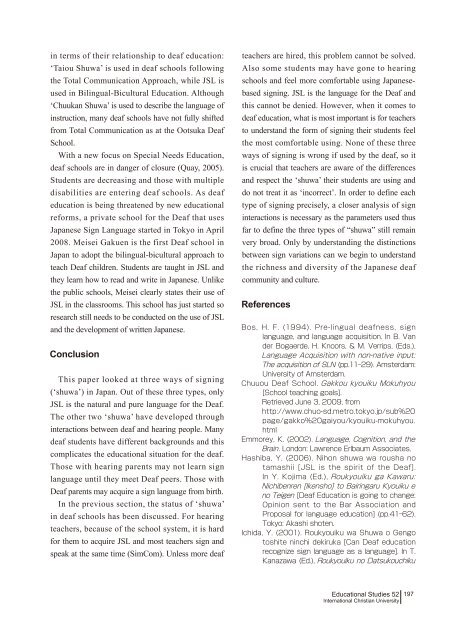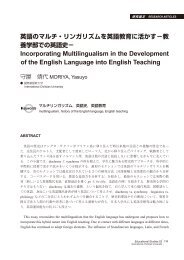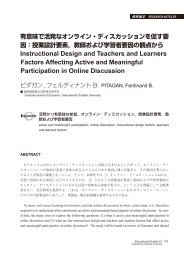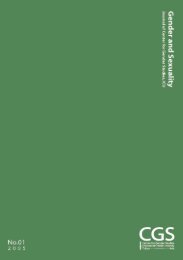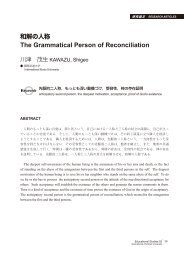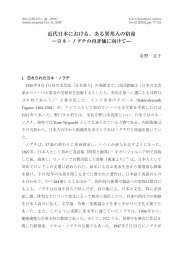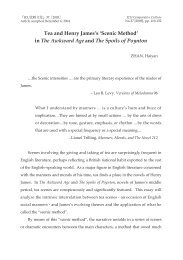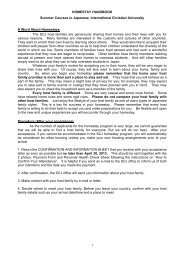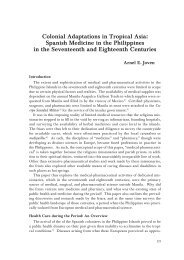Sign Language Variation and Implications for Deaf Education in Japan
Sign Language Variation and Implications for Deaf Education in Japan
Sign Language Variation and Implications for Deaf Education in Japan
Create successful ePaper yourself
Turn your PDF publications into a flip-book with our unique Google optimized e-Paper software.
<strong>in</strong> terms of their relationship to deaf education:<br />
‘Taiou Shuwa’ is used <strong>in</strong> deaf schools follow<strong>in</strong>g<br />
the Total Communication Approach, while JSL is<br />
used <strong>in</strong> Bil<strong>in</strong>gual-Bicultural <strong>Education</strong>. Although<br />
‘Chuukan Shuwa’ is used to describe the language of<br />
<strong>in</strong>struction, many deaf schools have not fully shifted<br />
from Total Communication as at the Ootsuka <strong>Deaf</strong><br />
School.<br />
With a new focus on Special Needs <strong>Education</strong>,<br />
deaf schools are <strong>in</strong> danger of closure (Quay, 2005).<br />
Students are decreas<strong>in</strong>g <strong>and</strong> those with multiple<br />
disabilities are enter<strong>in</strong>g deaf schools. As deaf<br />
education is be<strong>in</strong>g threatened by new educational<br />
re<strong>for</strong>ms, a private school <strong>for</strong> the <strong>Deaf</strong> that uses<br />
<strong>Japan</strong>ese <strong>Sign</strong> <strong>Language</strong> started <strong>in</strong> Tokyo <strong>in</strong> April<br />
2008. Meisei Gakuen is the first <strong>Deaf</strong> school <strong>in</strong><br />
<strong>Japan</strong> to adopt the bil<strong>in</strong>gual-bicultural approach to<br />
teach <strong>Deaf</strong> children. Students are taught <strong>in</strong> JSL <strong>and</strong><br />
they learn how to read <strong>and</strong> write <strong>in</strong> <strong>Japan</strong>ese. Unlike<br />
the public schools, Meisei clearly states their use of<br />
JSL <strong>in</strong> the classrooms. This school has just started so<br />
research still needs to be conducted on the use of JSL<br />
<strong>and</strong> the development of written <strong>Japan</strong>ese.<br />
Conclusion<br />
This paper looked at three ways of sign<strong>in</strong>g<br />
(‘shuwa’) <strong>in</strong> <strong>Japan</strong>. Out of these three types, only<br />
JSL is the natural <strong>and</strong> pure language <strong>for</strong> the <strong>Deaf</strong>.<br />
The other two ‘shuwa’ have developed through<br />
<strong>in</strong>teractions between deaf <strong>and</strong> hear<strong>in</strong>g people. Many<br />
deaf students have different backgrounds <strong>and</strong> this<br />
complicates the educational situation <strong>for</strong> the deaf.<br />
Those with hear<strong>in</strong>g parents may not learn sign<br />
language until they meet <strong>Deaf</strong> peers. Those with<br />
<strong>Deaf</strong> parents may acquire a sign language from birth.<br />
In the previous section, the status of ‘shuwa’<br />
<strong>in</strong> deaf schools has been discussed. For hear<strong>in</strong>g<br />
teachers, because of the school system, it is hard<br />
<strong>for</strong> them to acquire JSL <strong>and</strong> most teachers sign <strong>and</strong><br />
speak at the same time (SimCom). Unless more deaf<br />
teachers are hired, this problem cannot be solved.<br />
Also some students may have gone to hear<strong>in</strong>g<br />
schools <strong>and</strong> feel more com<strong>for</strong>table us<strong>in</strong>g <strong>Japan</strong>esebased<br />
sign<strong>in</strong>g. JSL is the language <strong>for</strong> the <strong>Deaf</strong> <strong>and</strong><br />
this cannot be denied. However, when it comes to<br />
deaf education, what is most important is <strong>for</strong> teachers<br />
to underst<strong>and</strong> the <strong>for</strong>m of sign<strong>in</strong>g their students feel<br />
the most com<strong>for</strong>table us<strong>in</strong>g. None of these three<br />
ways of sign<strong>in</strong>g is wrong if used by the deaf, so it<br />
is crucial that teachers are aware of the differences<br />
<strong>and</strong> respect the ‘shuwa’ their students are us<strong>in</strong>g <strong>and</strong><br />
do not treat it as ‘<strong>in</strong>correct’. In order to def<strong>in</strong>e each<br />
type of sign<strong>in</strong>g precisely, a closer analysis of sign<br />
<strong>in</strong>teractions is necessary as the parameters used thus<br />
far to def<strong>in</strong>e the three types of “shuwa” still rema<strong>in</strong><br />
very broad. Only by underst<strong>and</strong><strong>in</strong>g the dist<strong>in</strong>ctions<br />
between sign variations can we beg<strong>in</strong> to underst<strong>and</strong><br />
the richness <strong>and</strong> diversity of the <strong>Japan</strong>ese deaf<br />
community <strong>and</strong> culture.<br />
References<br />
Bos, H. F. (1994). Pre-l<strong>in</strong>gual deafness, sign<br />
language, <strong>and</strong> language acquisition. In B. Van<br />
der Bogaerde, H. Knoors, & M. Verrips, (Eds.),<br />
<strong>Language</strong> Acquisition with non-native <strong>in</strong>put:<br />
The acquisition of SLN (pp.11–29). Amsterdam:<br />
University of Amsterdam.<br />
Chuuou <strong>Deaf</strong> School. Gakkou kyouiku Mokuhyou<br />
[School teach<strong>in</strong>g goals].<br />
Retrieved June 3, 2009, from<br />
http://www.chuo-sd.metro.tokyo.jp/sub%20<br />
page/gakko%20gaiyou/kyouiku-mokuhyou.<br />
html<br />
Emmorey, K. (2002). <strong>Language</strong>, Cognition, <strong>and</strong> the<br />
Bra<strong>in</strong>. London: Lawrence Erlbaum Associates.<br />
Hashiba, Y. (2006). Nihon shuwa wa rousha no<br />
tamashii [JSL is the spirit of the <strong>Deaf</strong>].<br />
In Y. Kojima (Ed.), Roukyouiku ga Kawaru:<br />
Nichibenren [Ikensho] to Bair<strong>in</strong>garu Kyouiku e<br />
no Teigen [<strong>Deaf</strong> <strong>Education</strong> is go<strong>in</strong>g to change:<br />
Op<strong>in</strong>ion sent to the Bar Association <strong>and</strong><br />
Proposal <strong>for</strong> language education] (pp.41–62).<br />
Tokyo: Akashi shoten.<br />
Ichida, Y. (2001). Roukyouiku wa Shuwa o Gengo<br />
toshite n<strong>in</strong>chi dekiruka [Can <strong>Deaf</strong> education<br />
recognize sign language as a language]. In T.<br />
Kanazawa (Ed.), Roukyouiku no Datsukouchiku<br />
<strong>Education</strong>al Studies 52<br />
International Christian University<br />
197


